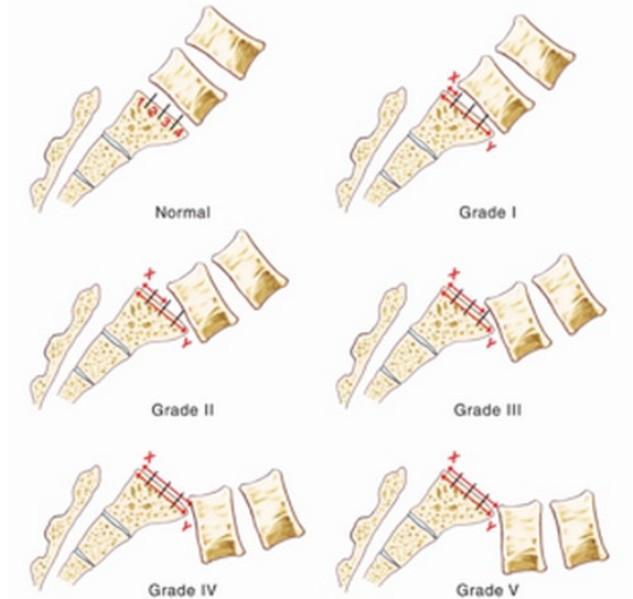Learn What is Anterolisthesis with its treatment, Causes, and Symptoms. It is a spinal cord disorder in which the upper vertebral body, slips forward onto the vertebra below. It is also called Spondylolisthesis.
Anterolisthesis, the term itself is combination of two words from different languages. First half “ante” is originally a Latin word that means “front” and “listhesis”, a Greek word that means “sliding down on a path that is slippery”. By combining two, you get a term Anterolisthesis, that means a front slide down a path that is slippery. That’s why anterolisthesis is used to describe the condition of the spine in which the upper body of vertebral, the area shaped like drum at the front of each vertebrae slips forwards on to the vertebra. In order to understand deeply, it’s better to understand the term vertebra.
The Vertebra are those bones that form an opening in which the human spinal cord passes through. Like stacks, the vertebrae are positioned on top of one another. At the front part of each vertebra is a thick part of bone that is shaped like a drum and is the referred as “vertebral body”. Between every two vertebrae, there are cushions like disks known as the intervertebral discs cushions. These discs are there to absorb and protect the spinal cord and the vertebrae from shock. In anterolisthesis, there is abnormal positioning of the upper vertebral body when compared to the body of the lower vertebra as they are slipped.
Anterolisthesis Grading
Grade 1 Anterolisthesis, Grade 2 Anterolisthesis, Grade 3 Anterolisthesis and Grade 4 Anterolisthesis are the four levels that represent the amount of slippage. The magnitude of slippage can be different, and it may graded by doctors in to scales from one to 1 to 4:
- Grade 1 Anterolisthesis: refers to mild slippage that is less than 25%.
- Grade 2 Anterolisthesis: the slippage is more than 25% but less than 50%.
- Grade 3 Anterolisthesis: the slippage is more than 50% but less that 75%.
- Grade 4 Anterolisthesis: the slippage is more than 75%.
Grade 4 can also indicate 100% in some cases and the symptoms are usually very severe in this grade.

Anterolisthesis Treatment, Symptoms, Causes
You want to know more about Anterolisthesis Grade 1-2, then continue reading. You will find all relevant information about its causes, symptoms as well as available treatments.
Anterolisthesis Causes
Anterolisthesis is a medical condition, in which there is a great impact on the spinal cord or the vertebra mainly the c4 and c5. It could be due to:
- falling from high heights,
- bullet wounds,
- injury from sporting activities
- impact from vehicle collisions
- core weakness or poor posture could be one reason
In order to avoid this condition, people are advised to engage in exercises for anterolistheis and to maintain good body posture when sleeping, sitting and in other daily activities, especially recommended for old people.
Anterolisthesis Symptoms
Anterolisthesis symptoms may vary from person to person, and also vary depending on the area that is affected by the slippage. Major symptoms include:
- Severe localized or widely spread pain at the point of vertebrae slippage.
- The muscular spasms or guarding may worsen the situation as the body attempts to protect itself, that results in tightening the muscles and inflammation.
- The pain may be experienced in one or both legs of the patient. Some patients complain weakness as well as numbness of the legs along with pain. Weakness of the muscles may cause serious damage to the body nerves and it should be addressed as soon as possible.
- Tingling, inability to control the legs and abnormal sensations
- Inability to control the passage of urine or bowel movements
Anterolisthesis Treatment
Although there are various Anterolistheis treatments but they vary depending on the intensity as well as severity of the condition. In most case, the X-ray image are required to determine the degree of anterolisthesis. If the X-ray becomes fail to give a detailed inside diagram then a Magnetic Resonance Imaging (MRI) or a Computer Tomography (CT) scan are done. It is unfortunate but true that the patient may not be able to regain the fitness that was there before the Anterolisthesis. The available Anterolisthesis treatments can be classified into two broad categories i.e. Conservative treatments and surgery.
Conservative treatments refers to non–invasive medical procedures. If the anterolisthesis does not present very severe symptoms, then conservative measures are priority. These measures are less costly and it actually offers complete recovery if it is professionally offered by qualified medical professional like physiotherapist.Rest and physical therapies are the most common conservative methods.
But if these treatments do not work, then the patient has no option but to undertake surgery. It is an invasive procedure that has various risks. In most cases however, the surgery is successful and the patient will get relief. The surgery for treatment of Anterolisthesis is referred to as interbody fusion. In interbody fusion, the surgeon will make an incision in the patient’s back. It is done through the mid layers of those ligaments and muscles which are positioned on both sides of the spine.
 Health & Care Information
Health & Care Information 

